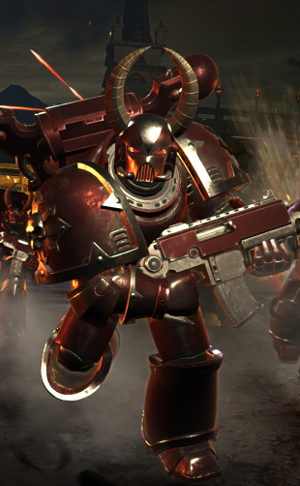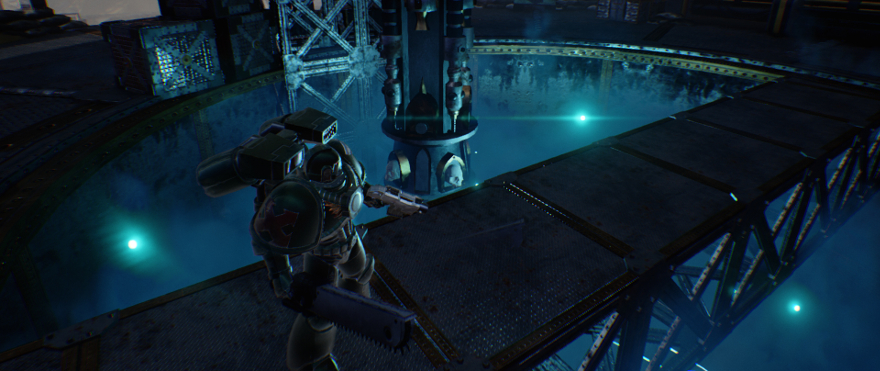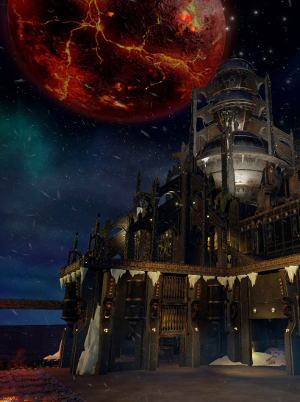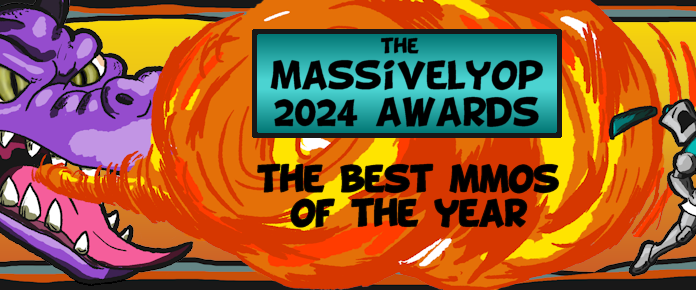
On Monday, I delivered to you the first part of my impressions of the newly launched Warhammer 40,000: Eternal Crusade, laying out both the basics of the game and whether it measures up as an MMO. Today, I’ll answer the second set — maybe the more important set — of questions my piece posed: Is the game finished, and is it fun?
Is Eternal Crusade finished?
Not even close. I mean, let’s say we set aside for a moment the previously-mentioned pushing back of the open-world elements of the game – elements that I consider to be core to the (ostensibly) planned vision of the game – which of course means that the game is by definition unfinished. Let’s say we set aside the fact that we are (ostensibly) talking about an MMO which, by the industry-standard principle of regular post-launch development and updates, are arguably never “finished.”
Even with those allowances, Eternal Crusade is, by almost every criteria, objectively unfinished. The idea that someone, presumably a person in a position of authority within the studio — or publisher, as the case may be — took even a cursory look at the current state of Eternal Crusade and said, “Yeah, that’s ready for launch,” is frankly inconceivable.
Let’s first consider the state of the game from the angle of content alone. As of this writing, the game’s highest-rated Steam review references this image that was, according to the reviewer, displayed on the game’s Steam store page “up until release,” though I can only personally vouch that it was displayed when I last visited the game’s Steam page around two weeks prior to launch. The image is an infographic that is headed with the text, “Eternal Crusade: the Game at Launch” and which, as you may have guessed, provides a visual catalogue of the game’s advertised launch features.
From the top, the infographic advertises four factions, each with five subfactions and warlords. There are in fact four factions, and they do have five subfactions each (although they, as I mentioned, are purely aesthetic and have no real bearing on the game as a whole), but unless I’ve overlooked it somewhere or haven’t progressed far enough to unlock the feature, there are no warlords (whatever they are) to be seen.
Next, a persistent world map with player driven campaigns, territorial conquest, player objectives, and clans and warparties. There is technically a persistent world map that provides a sort of territorial conquest, though we’ve already established how completely inconsequential to the overall game experience they are, and there are clans and warparties, which are just guilds and groups, respectively. The actual meat of these features, however – the player driven campaigns and player objectives – are entirely absent.
It holds true to its claim of five classes or more per faction, and of the three PvP gametypes listed, I played only Domination and Fortress, although I’ll admit it’s possible that Tug of War exists and was simply never chosen as the gametype for the games I played. I played quite a lot, though, so in my estimation that’s pretty unlikely. The purge, defend, and deliver Lair objectives are all in as well, though the infographic seems somewhat misleading here since they’re not really unique game modes in their own rights, just objective types within the Lair mode.
 I’m not about to try to count all the weapons and items in the game to validate the claims of there being thousands of weapons and such, but at this point that’s the least of the game’s worries. As for the three vehicle classes and the veterans, heroes, and elites, I’ve seen only two different vehicles (aesthetically unique but functionally identical for each faction), and while I know there are elite classes in the game, I’ve seen no mention of veterans or heroes.
I’m not about to try to count all the weapons and items in the game to validate the claims of there being thousands of weapons and such, but at this point that’s the least of the game’s worries. As for the three vehicle classes and the veterans, heroes, and elites, I’ve seen only two different vehicles (aesthetically unique but functionally identical for each faction), and while I know there are elite classes in the game, I’ve seen no mention of veterans or heroes.
Point is that just by looking at the disparity between the launch features that were advertised and the actual features that were delivered makes it clear that calling Eternal Crusade ready for launch is a stretch, and calling it anything approaching finished is flat-out laughable. And that would, perhaps, be forgivable if the features that did make it into the launch version were adequately polished.
Alas, they are not. Calling the state of the current game “rough” is akin to saying that a forest fire is a just a bit toasty. The most egregious offender by far is simple performance optimization: In order to get the game’s framerate to a point approaching playable – and even then just barely – I had to set the game’s graphics quality to minimum and edit an .ini file to manually adjust some other settings because the in-game settings options are atrociously limited.
This of course makes the game, which isn’t exactly graphically stunning even with everything cranked up to eleven, look like completely pixelated, washed-out garbage. But hey, at least it allowed me to actually play, even if my fps still plummeted when I did something as basic as viewing the scoreboard mid-game. If you were wondering why all of the images in this column are pulled from the game’s official site and not screenshots I took myself, now you know.
Then there’s the netcode. Oh, the horror. My twitch-shooting skills are decidedly average — slightly above average at best — so getting a bead on an enemy presents enough challenges as it is, but Eternal Crusade takes it up a notch by forcing players to try to land shots on enemies who skate, glide, rubber-band, and occasionally seem to teleport into another dimension entirely. Remember how I said that I reckoned Eldar have an edge over the other factions? This is why.
The movement speed of Eldar characters is, by design, faster than that of the other races, but with the game’s miserable netcode, what would otherwise be a slight mobility advantage becomes an impenetrable defense because you can’t kill someone if neither you nor the game itself has any idea where he actually is. In fact, the entire reason I settled on playing an Eldar character for most of my time with Eternal Crusade is that, after playing against them as the other factions, I quickly realized that it would take a verifiable act of god for me to actually hit one of the space-elfy buggers.
Now, let’s talk about the game’s controls. While the core mechanic of aiming and shooting is fine enough, almost all forms of maneuvering through the environment feel, at best, slightly sluggish and unresponsive. At worst, though, it can be downright rage-inducing. One of the first classes I experimented with before settling on the Dire Avenger was the Swooping Hawk, the Eldar jump-archetype class.
The Swooping Hawk’s trademark is its jetpack that can be used, at least in theory, to swoop (hawkishly, I presume) through the skies of the battlefield, raining destruction in strafing runs and assaulting hard-to-reach fortifications. In practice, however, using the class’s jetpack made me feel less like a hawk and more like an ostrich attached to a rocket-propelled hang glider.
Maybe I just utterly failed to grasp how the damned thing is supposed to be used — I’ll readily admit that’s a possibility — but here’s how I expect jetpacks to work in games like this: hold the spacebar to fire your jetpack, release the spacebar to deactivate it. That’s the standard method of jetpack control in most games I’ve played, and for good reason: It’s simple and intuitive. The functionality of the Swooping Hawk’s jetpack, however, baffles me still, but as far as I could determine from its erratic behavior, it works like this: hold the space bar to boost into the air, then let it go when you’re at your desired height, where you will continue to hover until you press the spacebar again, deactivating the jetpack and returning you to the ground.
But it wasn’t just the nonstandard implementation of the jetpack itself that threw me off — I can adapt to something like that. No, the real problem is that apparently the moment I left the ground, I suddenly became nearly frictionless, zipping through the air at breakneck speeds with no feasible way to actually maneuver with any degree of precision. Using the jetpack to jump through a building’s elevated window to ambush the enemies within, an action that would be effortless in, say, PlanetSide 2, is an exercise in wall-colliding frustration.

It’s not just aerial mobility that suffers, however; terrestrial maneuvering has its fair share of equally frustrating problems as well. First there’s the matter of vaulting. Eternal Crusade, in the vein of Gears of War does not give characters the ability to jump. If there’s an obstacle between where you are and where you want to be, your only option (unless you’re one of the jump-archetype classes) is to vault over it. But that’s fine; lots of games use that mechanic, so how badly could they screw it up?
Very, as it turns out. Vaults will sometimes fail to execute if you approach the barrier from any angle but directly head-on. That can be worked around, though, as long as you know to expect it. The real problem with vaulting is that it seems to work only on barriers that have been explicitly designed to be vault-able. This means that any obstacle that does not fall under this category — often in the form of knee-high rocks or piles of debris — becomes an insurmountable roadblock.
On one occasion that stood out to me, I vaulted over the railing of a walkway and ended up on a rocky precipice. To one side of me there was a sheer cliff that terminated in a lake of lava; to the other, some slightly elevated rocky terrain that anyone capable of lifting their feet more than a few inches off the ground should have been able to navigate back to safety. Unfortunately, the game wouldn’t let me vault over the six-inch high ledge blocking my progress, so into the lava I went.
Along with vaulting, the game’s cover system also proved to be an exercise in anger management. Rather than using the standard — and in my opinion plainly sane — cover system whereby you simply approach your desired cover and press a designated “take cover” button, Eternal Crusade attempts to contextually determine whether you’re trying to take cover behind something, and more often than not it fails miserably.
Taking cover while standing — e.g., pressing yourself up against a wall to peek around the corner, for instance — is a total crapshoot. As there’s no “take cover” button, you instead have to just run directly into the structure you want to hide behind and hope for the best. As with vaulting, however, this process doesn’t always go smoothly unless you approach your cover straight-on, and even then the game sometimes seems to decide that you really just wanted to run in place against a wall for a few minutes.
Crouching cover is handled slightly better, but only because the game actually provides you a contextual cue when you’re standing in front of a barrier that you can crouch behind for cover. All you have to do is press the crouch key when you see the HUD notification and voila. Still, there were numerous instances when I was standing behind a barrier that I should have been able to crouch behind, but the game just wouldn’t let me do it.
Finally, I want to talk a little more about the melee combat. For reference and due credit, just about everything I know about melee combat in Eternal Crusade I learned from this Steam community guide by Steam user Laanshor–Karrdo because the nuances of the melee combat system are not adequately explained in-game, so kudos to him for enlightening the masses.
Here’s a quick rundown on how melee combat is supposed to work: There are five different types of melee attacks: fast attacks, charged attacks, defensive bash, evade attack, and sprint attack. When two players engage in melee, attacks of the same type cancel each other out (called “clanging” by the community, so named for the sound effect that plays when this occurs), while attacks of different types interact rock-paper-scissors style. Fast attacks beat out charged attacks, charged attacks beat out defensive bashes, and defensive bashes beat out fast attacks. There are a few slightly more detailed mechanics at play as well, but those are the basics.
On paper, that sounds like a pretty solid combat system, or at least a deeper one than the barebones “bash each other until someone is dead” system that you usually see in FPS and TPS games. In practice, though, Eternal Crusade’s melee combat is rather hit-and-miss, and I mean that both figuratively and literally. While many games with a focus on fast-paced, hack-and-slash-style melee combat provide some kind of contextual assistance that recognizes when you’re aiming for a certain enemy even if you’re not perfectly lined up in front of it, Eternal Crusade eschews this idea.
 Some players may applaud this decision as an effort to minimize “hand-holding,” as it were, the result is that most melee skirmishes seem less like duels between highly trained combatants and more like two toddlers with toy swords fumbling haphazardly around, occasionally landing a hit on accident. Most melee attacks — at least for the Eldar — include some kind of lunge before the actual strike, and the distance of the lunge doesn’t seem to be adjusted based on your distance from the enemy, so if you haven’t gauged your range just right, you’re likely to find yourself charging directly past your opponent and presenting him your back for easy stabbing. Needless to say, the aforementioned shoddy netcode doesn’t help matters either.
Some players may applaud this decision as an effort to minimize “hand-holding,” as it were, the result is that most melee skirmishes seem less like duels between highly trained combatants and more like two toddlers with toy swords fumbling haphazardly around, occasionally landing a hit on accident. Most melee attacks — at least for the Eldar — include some kind of lunge before the actual strike, and the distance of the lunge doesn’t seem to be adjusted based on your distance from the enemy, so if you haven’t gauged your range just right, you’re likely to find yourself charging directly past your opponent and presenting him your back for easy stabbing. Needless to say, the aforementioned shoddy netcode doesn’t help matters either.
The game does provide a lock-on system in the vein of Dark Souls — though curiously, it’s usable only when you’re wielding a smart pistol or shield alongside your melee weapon — that allows you to set your focus on an enemy, and while locked on to someone, your movement is adjusted to be relative to that of your lock-on target, meaning you’ll strafe in a circle around them when moving to either side.
Unlike the lock-on system of Dark Souls, however, the system as implemented in Eternal Crusade does not actually make it so that your attacks are automatically executed in your lock-on target’s direction, so while it does help to keep an eye on your enemy, it provides no help at all in actually landing attacks on them. Don’t get me wrong; I understand that melee attacks are incredibly powerful when used effectively, maybe too powerful in some cases, but there’s not a lot of excitement or satisfaction to be had from watching an Ork and a Space Marine charge at one another, choppa and chainsword at the ready, only to lunge past one another in a series of embarrassingly inept whiffs until they decide to just stand toe-to-toe and slug it out.
In light of all of the above, it should come as no surprise that the game’s graphics and animations are in a similar state of disrepair. Even on higher (i.e., unplayable) graphics settings, many of the game’s textures are muddled and bland, and the character models look like they were made for a last-gen console game. It’s a shame because there really is some great visual design at work, especially in the architecture and the world itself, but even a Van Gogh would look amateurish in crayon.
The animations, likewise, are rigid and uninspired. Special mention goes out to the Eldar dodge animation, which I reckon is supposed to be a graceful and acrobatic aerial flip but is so stiffly and mechanically animated that it’s anything but. It looks like the animation consists of the model being abruptly flipped upside down, moved a few yards in a given direction, then just as abruptly returned right-side up.
That example, although particularly conspicuous, is ultimately just a matter of aesthetics, but in other cases, the low-quality animations are actually damaging to the gameplay itself. Specifically, I’m talking about melee attack animations.
Eternal Crusade’s melee combat system, although far from perfect, actually has the potential to be one of the more interesting facets of the game. As I mentioned earlier, players can perform a variety of different melee attacks – light attacks, heavy attacks, stunning bash attacks, etc. – and a significant portion of the strategy derives from reading your opponent’s attacks and responding accordingly. The melee attack animations, however, almost completely nullify any interesting mechanics at play because they’re so unnatural and frequently indistinct from one another that the prospect of reading and responding to an opponent’s attacks is beyond the abilities of a player with average reflexes.
Even the gunplay, which should be almost impossible to screw up, suffers some casualties from the game’s rough state of affairs. When gunning down enemies in Eternal Crusade, it’s often difficult to tell if your shots are hitting and, if they are, if they’re actually doing any damage whatsoever. This problem stems from the fact that there’s not much in the way of feedback for successful shots.
There is an audio cue – a high-pitched “ping” sound that may be intended to sound like clashing metal but utterly fails to be convincing – but I didn’t notice much in the way of visual feedback like, for instance, sparks flying as the projectiles from my shuriken catapult struck a Space Marine’s power armor. I mean, if your aim isn’t terrible and you shoot someone enough, he will die, so it’s not that shooting things isn’t effective; it’s just that the lack of feedback makes it feel unsatisfying, like you’re trying to take down a tank with a peashooter.
Now that I’ve outlined the many ways in which Eternal Crusade is unpolished and unfinished, I suppose it’s time to answer the final question, though at this point you should probably have an idea of what’s coming.
Is Eternal Crusade fun?
With no small degree of sorrow and reluctance, I’m going to have to say “no” yet again. Assuredly, there were moments during my time in the game when the stars aligned and I, startlingly enough, found myself enjoying it. But even those ephemeral moments didn’t inspire anything beyond a kind of complacent sense of entertainment, and they were nowhere near enough to compensate for the tedious dullness of the intervals between them.
I want to be able to say that Eternal Crusade has the potential to be a good game, but it’d be like grabbing a random chunk of coal and saying it has the potential to be a diamond. Sure, it theoretically could happen, but the odds aren’t leaning that way. The sheer amount of work it would take to bring only the game’s current features to a state worthy of an official release (which, it should be noted, is currently being sold for full price at $49.99 U.S.) is daunting in and of itself. By the time the game has been developed and updated enough to even begin to deliver on the promises of a full-fledged, open-world MMO shooter, we’ll probably be too busy with our holodecks, matter replicators, and interplanetary vacations to notice.
There’s nothing that Eternal Crusade has to offer that games like PlanetSide 2 — or even non-massive titles like the Battlefield series, for that matter — don’t provide with exponentially more polish and feature-completeness. In the grim darkness of the future, there’s only war, but it’s probably still a hell of a lot more pleasant than the unpolished facsimile thereof that Eternal Crusade presents.













